Manchester City’s Pauline Bremer brings us a player with an interesting skill set. Through analysis, we see that Bremer is a dangerously dynamic forward and on an individual level has the quality to improve any team’s attacking tactics. Although her time with City has been marred by gruesome injury, tactical analysis shows us that Bremer excels not just with her feet, but with her mind. This scout report will look into how Bremer is able to score goals at such a high rate, but also touch on why she has not made a bigger impact in the City squad. We will then look at what the future may potentially hold for her.
Background
Born in Ossenfeld, Germany, Bremer progressed through the youth system of SVG Göttingen 07 before signing a senior contract with 1. FFC Turbine Potsdam in 2012. After a few years, perennial powerhouses Olympique Lyon took notice of her and landed her signature in 2015. By 2017 Manchester City were looking to elevate their squad and having just lost to Lyon in the Champions League semi-final signed Bremer to a contract through summer 2020.
Bremer has excelled within the German women’s national team as well. Her first splash on the international level came when she was a major component in the German squad that won the UEFA Women’s U-17 Championship. A year later she was the top scorer in the 2013 UEFA U-19 Championships. Another year after that, she helped Germany to win the 2014 FIFA U-20 World Cup. Since 2014 she has struggled to find a foothold in the German starting XI, featuring with the German first team 21 times and scoring 4 goals.
Tenure with Manchester City
Bremer’s tenure with Manchester City is an interesting one. Bremer made her starting debut with City in October 2017 in a match against Everton. She scored within the first twenty minutes of the match and the future looked quite bright. However, late in the first half, Bremer suffered a broken leg after a heavy challenge by a defender. This left Bremer out for thirteen months.
After a long bout of rehabilitation, Bremer began to find her form on the pitch again. She has shined brightly this season by scoring the third-most goals in the league with 10 and ranks highest in goals per 90’ with 1.44. She also ranks fifth in the league for shots taken with 45, with an enormous 6.47 shots per 90’. To put that in perspective, the next highest shots per 90’ is Beth England with 4.03.
Bremer is obviously an attacking force in the English first division, but there are a few alarming follow-up statistics. Of Manchester City’s 1,440 minutes played in the 2019/20 FAWSL, Bremer has only been present for 576 of those minutes (40%). Additionally, out of the 16 matches played, Bremer has only started 6 of them.
This leads us to wonder, why would City not play Bremer, who is ranking in the top ten in the league in multiple key scoring statistics? Why is she present less than half of Manchester City’s time on the pitch? In a Goal.com interview with Nick Cushing in January 2020, we find some insight:
“I’m not being critical of her goal-scoring but her all-round build-up play, it has to improve,” manager Nick Cushing added. “We want to work on it, we want to get her better. Between the two boxes, she can be a better player, but in the box, she’s showing that she’s an incredible goal-scorer. She’s scoring a lot of goals, but she’s missing a lot of chances as well, so she can score even more! And she knows that. But, like I say, we can’t be critical of her goal-scoring.”
This leads us to believe that despite Bremer’s tremendous skill set, she is not an ideal fit for City’s desired tactical system. This is not unusual; we see players all the time that don’t fit well with one team’s tactical format and then flourish in another tactical format (a good example being a comparison of Kevin De Bruyne’s tenure with Chelsea and Manchester City).
In late February 2020, it was announced that Bremer would be leaving City at the end of her contract in the summer to join VFL Wolfsburg. We will take a look at some of the ways Bremer is able to score so many goals and how she might fit in within VFL Wolfsburg’s tactics.
Off the ball runs
Bremer is quite skilled at confusing and disorienting her direct defender. By allocating different runs based on her direct opponent’s range of vision she is able to lose her marker in vital moments to create chances on goal.
Studies across different mediums (athletics, office work, etc.) have shown that when people are interrupted and have to switch their attention back and forth from a task to task they take, on average, 50% longer to accomplish their task and make up to 50% more errors. If a person is forced to focus on multiple things, their quality of thought and execution is diminished. Add the intensity and speed of a football match and an attacker can use this cognitive confusion to their advantage.
Bremer can be seen doing this by using different types of runs against her direct opponent. She uses a mix of runs within the defender’s vision, out of the defender’s vision and sometimes both within one run.
Bremer is constantly aware of the eyeline and body shape of her marker. This allows her to choose when to stay in her opponent’s blind spot and when to appear. She often lurks in her marker’s blind spot to force the defender to take their eye off the ball to find her. When the defender observes her, she remains in her position, knowing the defender is taking a mental snapshot of Bremer.
The moment the defender turns her vision away from Bremer, Bremer moves into a new space. By doing this throughout her play, she is able to confuse and disorient her direct marker. Because of this disorientation, the marker is prone to more mistakes and Bremer finds more opportunities to score. Sometimes this happens even when Bremer is directly in the vision of the marker.
Below we can see a few examples from a single match in September 2019. Bremer remained in a high position alongside the Reading centre-backs throughout the match. When the ball was not near her, she constantly moved to create awareness issues for the Reading backline.
When the ball came near and it was time to make an attacking run, she used an alternation of different runs to keep the defenders guessing.
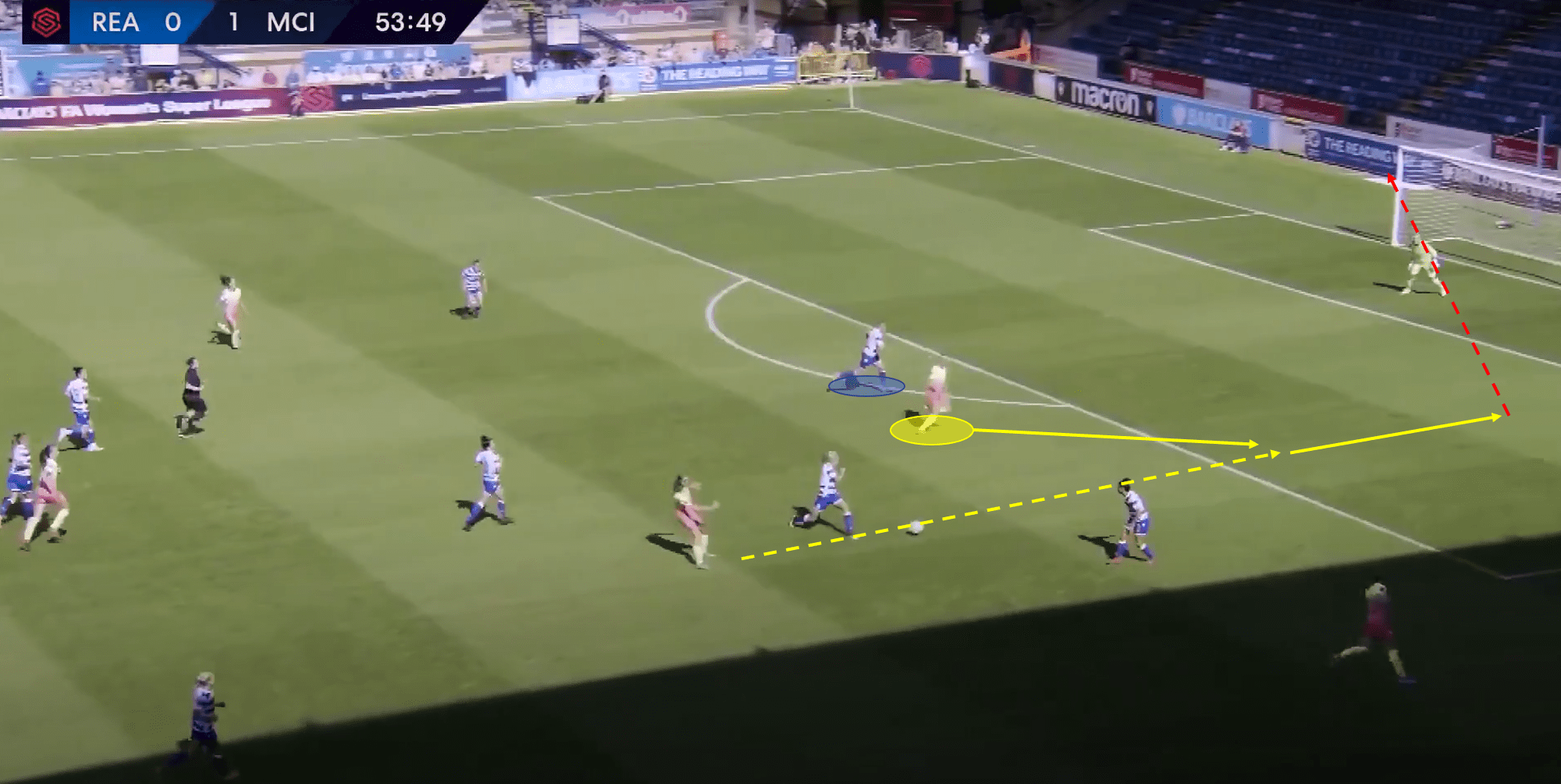
Above is a run in the second half in which Bremer chose to remain in the view of her marker and make a run into space behind. It must be mentioned that Bremer is certainly a top athlete as well and her bursts of speed make her additionally dangerous. She is able to get away from her marker and create a chance on goal.
Later, the ball is on the Manchester City right flank. Bremer is aware that her marker’s vision (blue) is fully attached to the ball on the flank. Bremer stays in her direct opponent’s blind spot to move to the top of the 6yd box practically unmarked. A cross is sent in and Bremer’s one-touch shot narrowly misses.
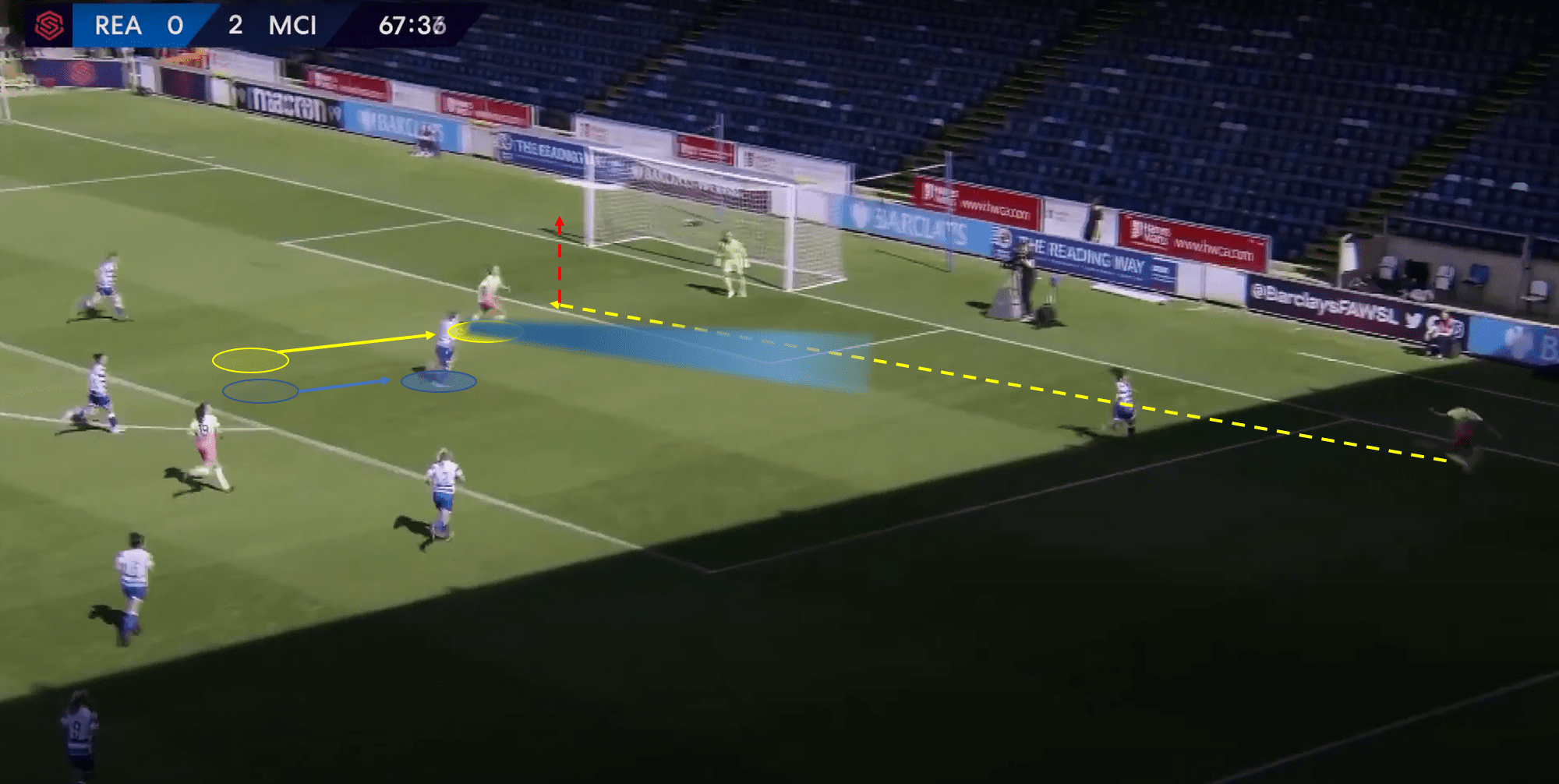
Having used runs both in and out of her marker’s range of vision, Bremer is also able to use both within single runs to create chances on goal. In a moment in which City have played the ball to the left halfspace, Bremer sees that she has a few defenders directly between her and the ball. Successfully receiving a pass in this situation is not likely.
Because Bremer is in her marker’s blindspot, the marker is forced to take her eye away from the ball to see where Bremer is. The defender sees that Bremer is travelling forward and assumes that she will continue on that trajectory. A mental snapshot is taken.
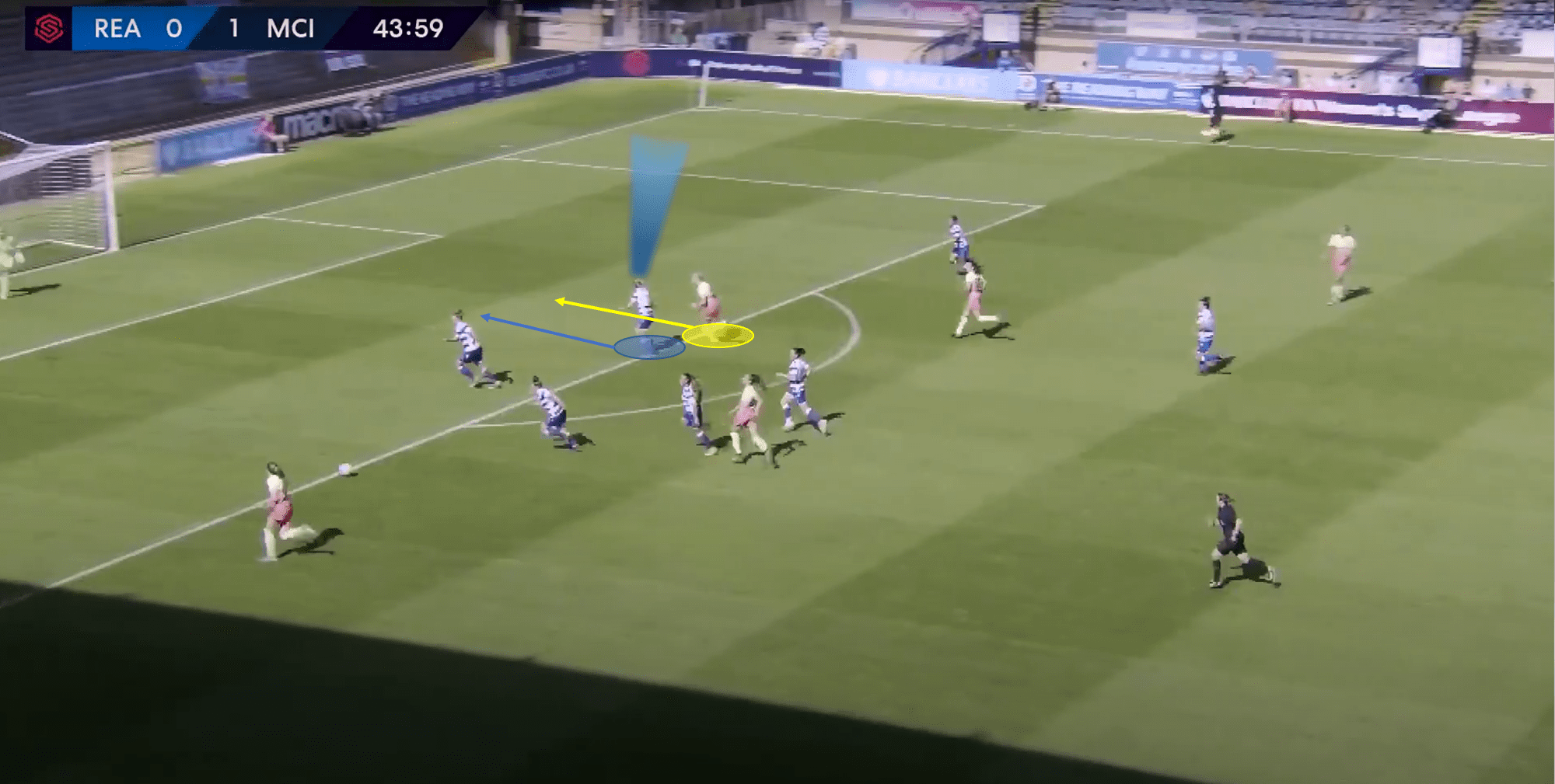
As the defender turns her vision back to the ball, Bremer prepares to pounce. When her City teammate is about to deliver a cross, Bremer bursts from behind her marker and moves to her front side. As the ball travels, Bremer is now in a position to head the ball in with little interference from her marker.
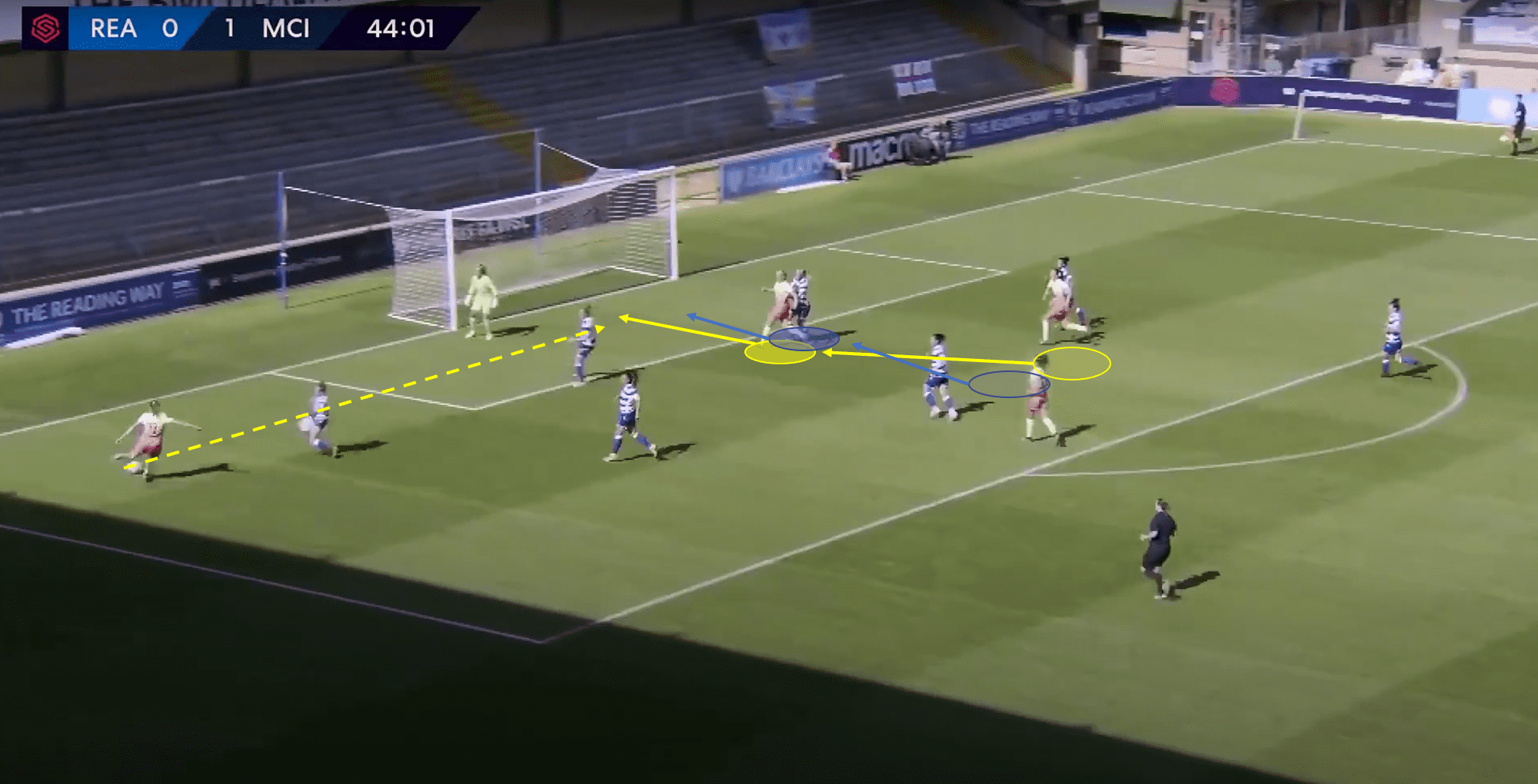
By constantly moving in and out of her direct marker’s vision and allocating different types of off the ball runs, Bremer is able to create opportunities for herself to score goals. This is all built on her ability to constantly make her direct opponent divert their focus and her creation of confusion in attacking moments.
Space interpreter
A major facet of Bremer’s play is her ability to conceive and interpret space around her. Pair this spatial awareness with the ability to appear in theses spaces at dangerous moments and you have a striker who can do major damage in the opponent’s box.
Thomas Müller, once prompted with a question on his playstyle, responded with “Ich bin ein Raumdeuter.” This can be roughly translated as “I am a space interpreter.” He went on to add: “It’s all about the timing between the person who plays the pass and the person making a run into the right zone.”
Bremer can be seen as a Raumdeuter as well. She not only able to scan and perceive space around her, but she is also able to time her runs into the spaces to maximize her effectiveness in creating chances on goal.
We see a few examples of this in a match against Everton in January of this year. Lauren Hemp has just successfully recovered the ball on the left flank. Bremer, who is positioned centrally between the Everton centre-backs, physically communicates that she wants a through ball into the box. Bremer quickly realizes that a through pass would not make it to her due to the Everton centre-back’s nearby position.
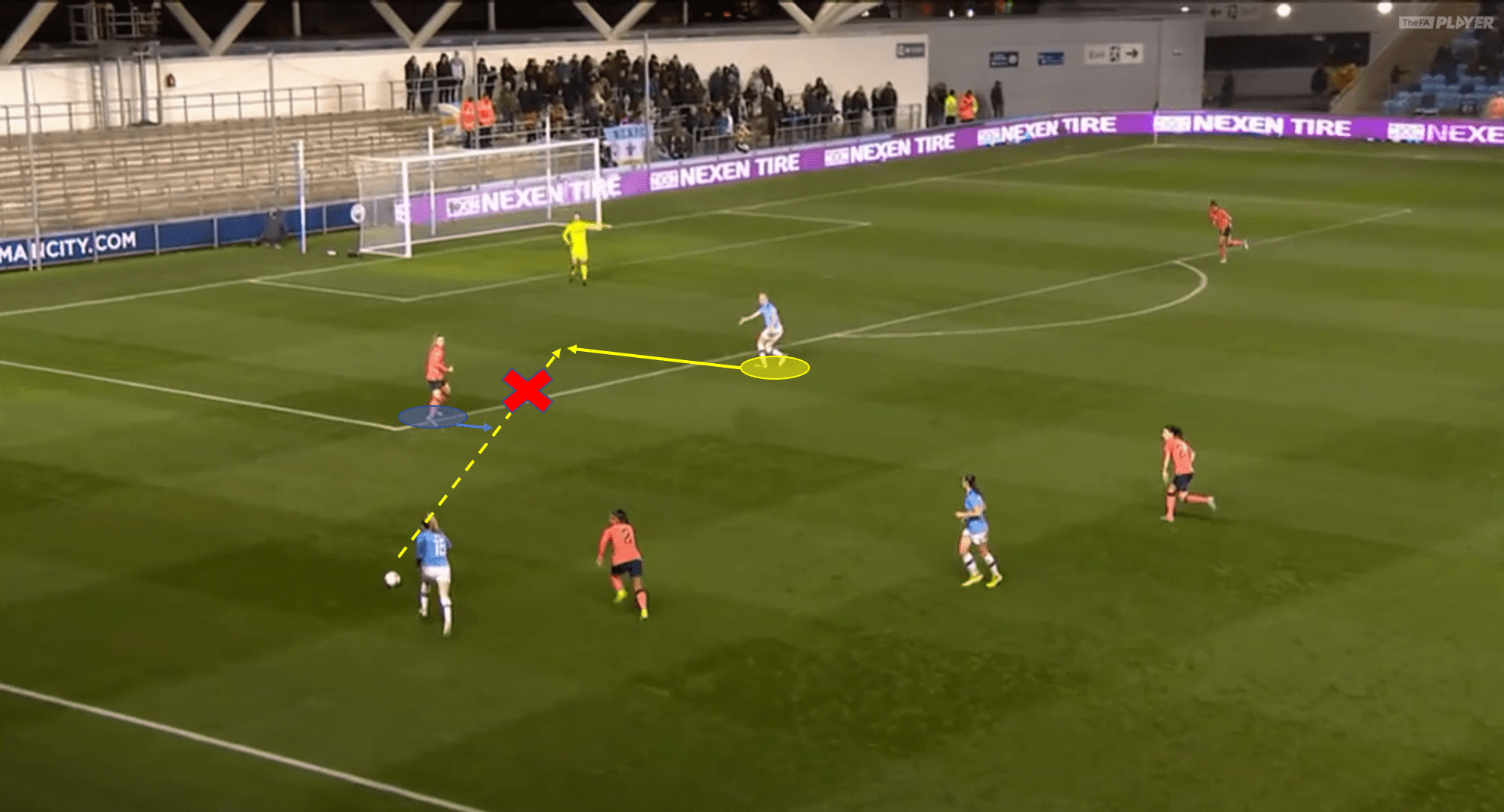
Bremer promptly scans her surroundings and sees that she can find vertical space between the defensive and midfield lines as well as horizontal space between the central Everton players. As the nearby opposition are focused on Hemp’s attacking run, Bremer discretely moves into central space.
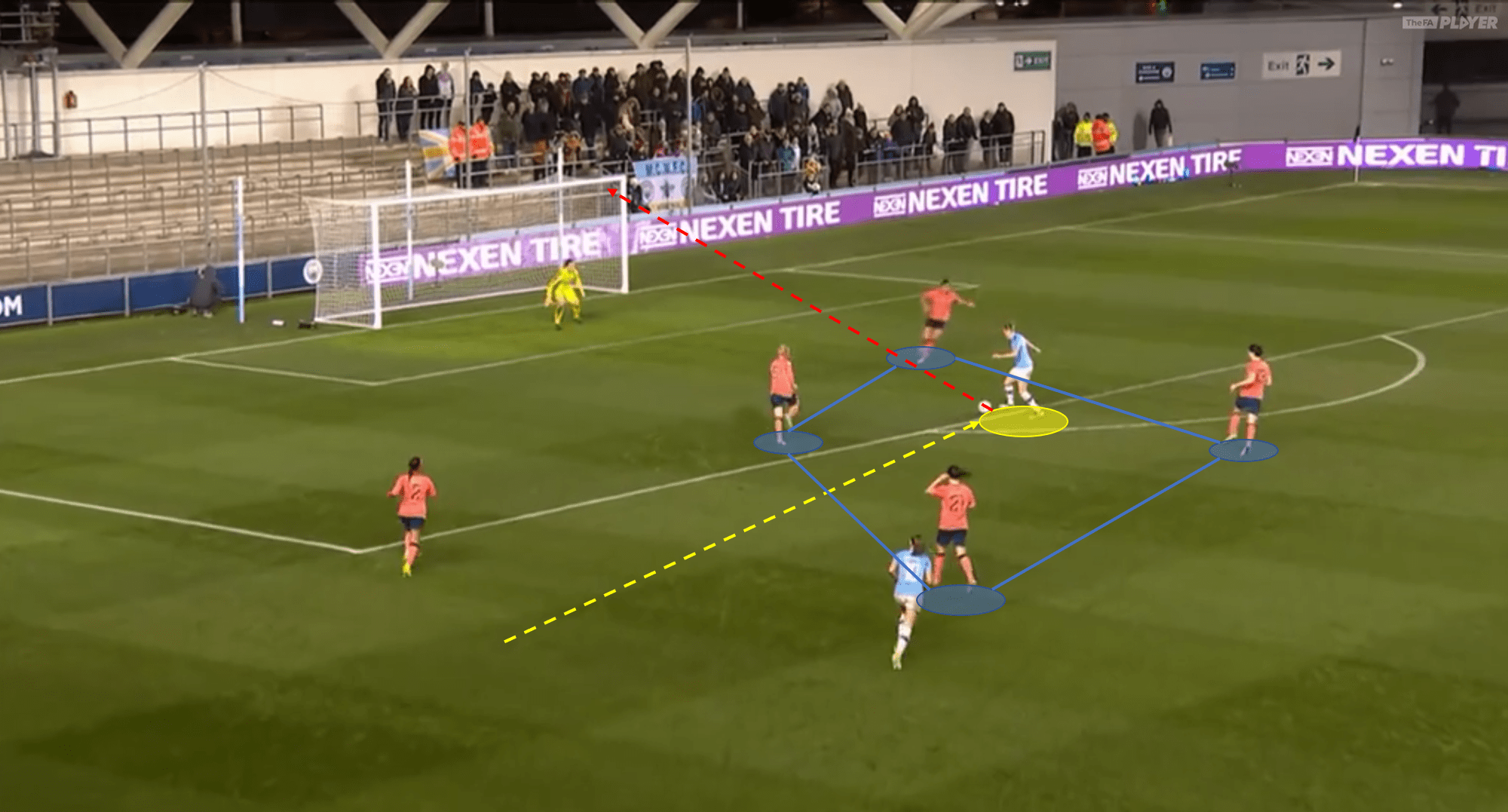
Bremer then receives the ball across her body and is able to quickly fire a shot into the upper corner of the goal. Bremer’s positioning to receive not only put her in a large amount of dangerous space but was also consciously an equal distance from all nearby opposition. This created a situation in which the Everton players did not know who would directly pressure Bremer. No one adequately pressured Bremer and she was easily able to score a goal from the top of the box. Bremer chose the exact time and location to create the most problems.
We also see a more subtle spatial occupation in the Everton match. The timing of movement into space becomes more crucial as an attacker is closer to the opponent’s goal due to intense and immediate pressure from multiple opponents.
In this moment, Bremer sees that a teammate is penetrating into space in Everton’s box. Bremer also scans and sees that there is a large amount of space to her left. Bremer wants to receive the ball in this space, but she is aware that if she moves into it immediately, she will drag a defender with her and the space to receive will be taken away. Bremer is also aware that her marker’s vision (blue) is fixed on the attacking run of her City teammate.
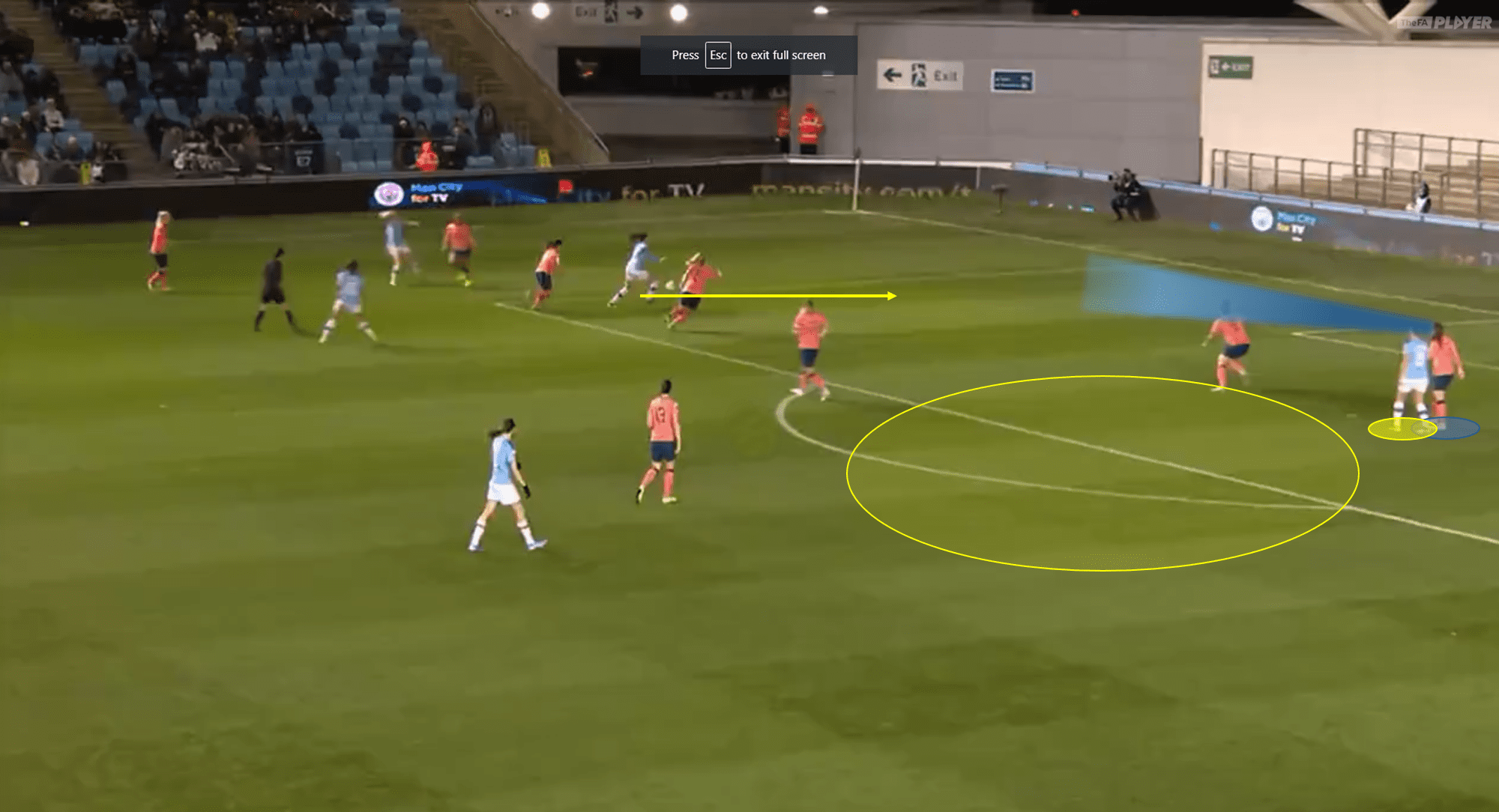
Bremer remains patient and awaits the opportunity to move into the space. The moment her marker moves forward towards the 6yd box to block off the City attacking run, Bremer breaks to her left unmarked. Note in the image below that Bremer and her marker’s shoulders are beginning to move in two different directions.
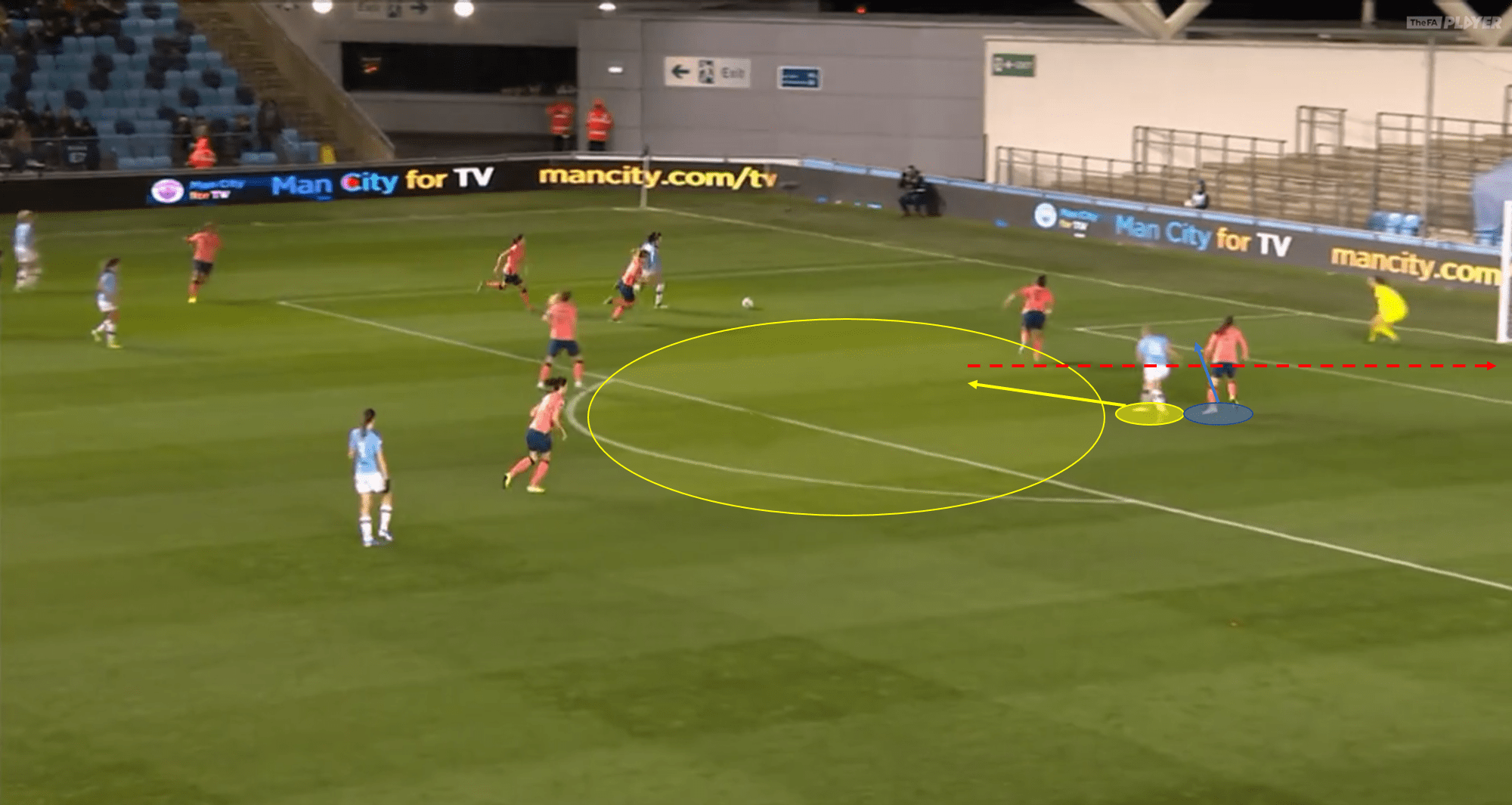
By initiating her run exactly at this moment, Bremer is able to move into the open space almost completely unmarked. A cutback pass is played to Bremer and she is able to score.
By constantly being aware of space around her and carefully timing her movements into said space, Bremer is able to appear in dangerous areas and inflict goals on the opposition.
How she might fit in with Wolfsburg
Bremer seems to excel as a traditional number nine that stays high and lurks around the opponent’s centre-backs. This may not be a perfect fit within Manchester City’s attacking tactics, but she may flourish within VFL Wolfsburg’s attacking manoeuvres.
Wolfsburg have one of the most intense presses in Frauen-Bundesliga with 25% of their recoveries occurring in the final third (highest in the league). They also like to play the ball into the box from the flanks, averaging 27.08 crosses per 90’. This is quite high considering that the next team’s highest average crosses per 90’ is 18.9.
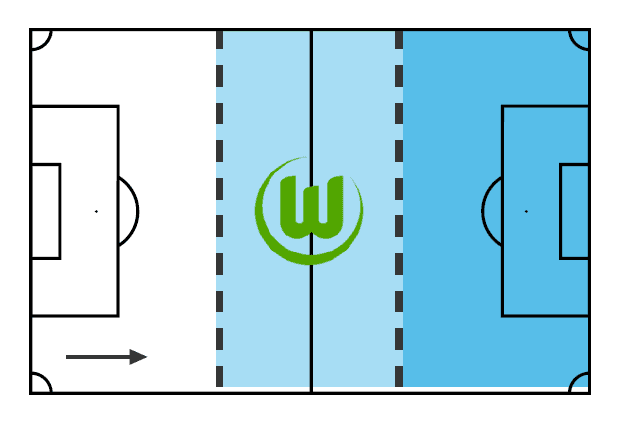
This ability to win the ball, play it wide and then cross into the box may be a perfect fit with Bremer’s skill set. As we’ve already covered, part of Bremer’s ability to make effective attacking runs and “interpret space” is based around using her marker’s blind spots as a tool. With Wolfsburg creating many of their attacks from the flanks, Bremer may be able to thrive in these situations when defenders attention is drawn away from the centre of the pitch.
Wolfsburg also have the shortest average shot distance in the league with 15.56 meters from the goal. Wolfsburg excel at effectively penetrating the ball into the box to create quality chances directly in front of the goal. Below we can see a map of all of Wolfsburg’s goal locations in the 2019/20 season.
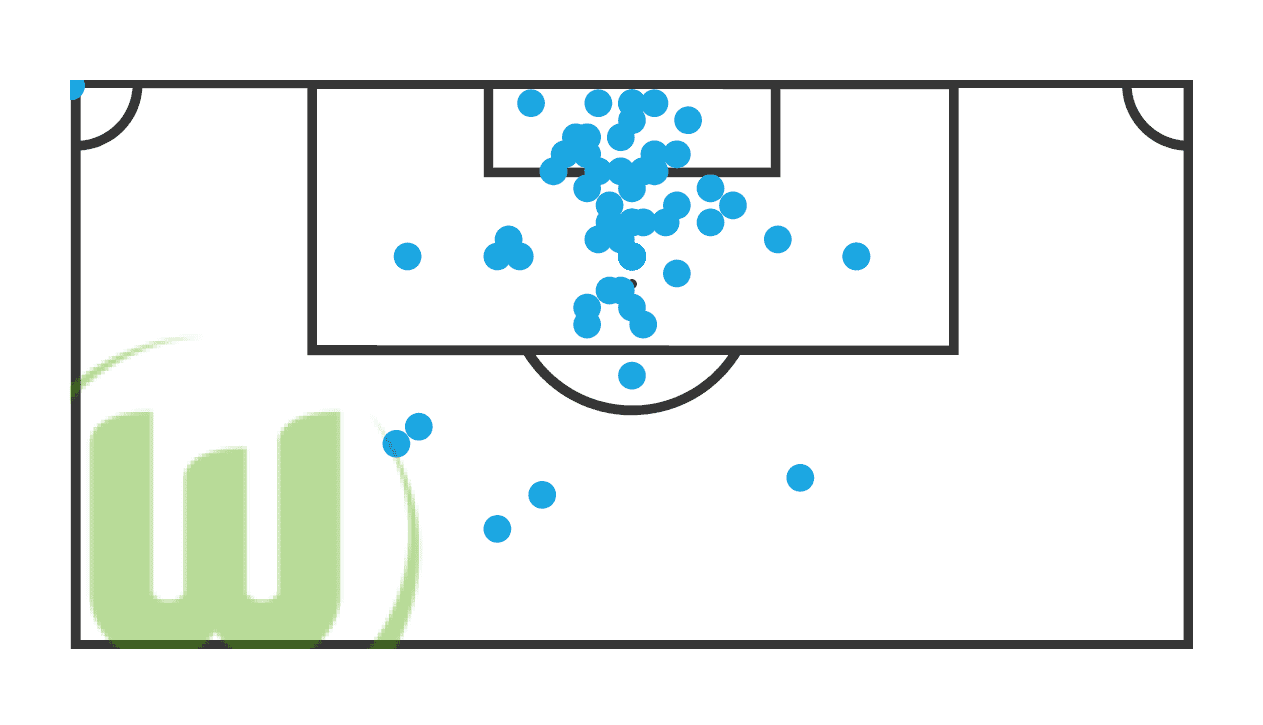
Put that map alongside Bremer’s career heatmap and we see some very similar results. Bremer could thrive in this attacking setup.
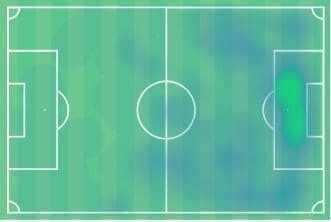
Additionally, Wolfsburg currently have Frauen-Bundesliga leading goal scorer Pernille Harder. At this moment, her contract with Wolfsburg is due to expire this summer, but we can see that she would potentially pair perfectly with Bremer as a striking partner.
Wolfsburg defend in a 4-4-2, but when in attack prefer to have a striker move high to occupy the opposing centre-backs while Harder drops as a false nine or number ten. Below we can see Harder’s attacking actions map. She is not prone to remain in one location on the field, but we can see that she tends to concentrate on the area in front of the opponent’s box. Once again, this could be a perfect fit with Bremer’s positional style.
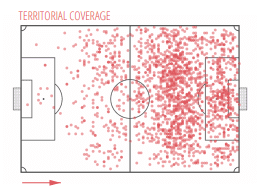
An opposing team that have to deal with a flurry of crosses while Bremer tactfully finds space in the box and Harder roams just outside are going to have a difficult time. Bremer seems to be an almost ideal fit within the Wolfsburg tactical system.
Conclusion
Bremer may be leaving Manchester City without creating a maximum impact, but it is clear that she is quite a cerebral and talented playmaker. She is bound to make quite an impact with her move to Wolfsburg and may give the club the final crucial piece to win a recently elusive Champions League final.




Comments